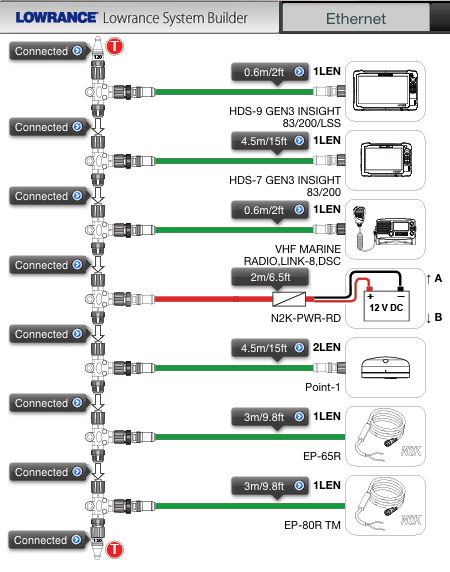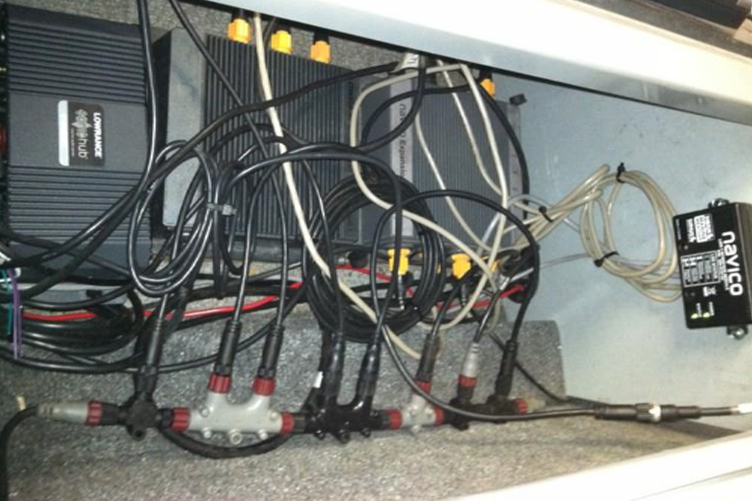Ethernet vs NMEA Networking: What do they do?
One of the great features of today's modern fishing electronics is the ability to bring in data from outside sources (antennas, electric motors, temp probes etc.) and the ability to share any data from one unit on any or all of the other units in a boat. Lowrance uses two unique systems to share data between units.
First, is the Ethernet system. This is a simple system, requiring a single cord between units to allow data sharing. With the Lowrance units the following data can be shared between units using an Ethernet cable:
a. Sonar data: the sonar "source" can be selected at each unit and ANY transducer that is connected to any unit can be viewed at any location. For example, when trolling with a bow mount electric equipped with a transducer, you could view that transducer on a unit mounted on the console so you are seeing what is happening at the front of the boat, not behind you.
b. StructureScan data: If your system is equipped with an LSS (Side and Down scan)/TotalScan or ActiveView transducer, the input can be viewed on any unit that is connected via Ethernet cable to the unit receiving the input from the transducer. On older "button" units, a LSS box was used to plug the StructureScan transducer into. The box had 3 Ethernet outputs allowing up to 3 units to be sharing Ethernet data.
c. Waypoints: All HDS/Carbon/LiVe units connected by an Ethernet cable can share waypoints. By saving a waypoint on any unit, the waypoint will also be saved on all other units connected via Ethernet cable
d. Map Chip data: on the newer units, one map chip can be viewed on all units connected to the unit where the map chip is inserted.
e. Weather/Radio/Radar: the Sirius Weather and/or radio services can be shared to multiple units as can the 3G and 4G Lowrance or Simrad radar systems.

One of the questions we get a lot is "how many units can I hook up on an Ethernet system?" The answer is simple…unlimited units. You can "daisy chain" as many units and inputs together as you need, but there is a catch. The Gen2 5 and 7" units have only 1 Ethernet port, allowing a unit to only share with a single other unit. The Gen2 8, 9, 10 and 12" units each have 2 Ethernet ports, allowing 2 additional units to be hooked (for a total of 3 in the system). All Gen3/Carbon/LiVe units, regardless of screen size have 2 Ethernet ports. If you need more capability, especially if using the Sirius or Radar products, you can install a NEP-2 expansion port. This box allows up to 4 inputs/outputs and increases the number of products/units used on an Ethernet system. In extreme cases, multiple NEP boxes can be hooked together to provide unlimited inputs and outputs.
The second system is the NMEA 2000 or "LowranceNET". Often simply referred to as a "Network" this system allows users to bring in data from outside inputs such as GPS antennas, temperature probes, engine data, fuel level and flow, MotorGuide Xi5 electric motors and others. In addition, a network can also be used to share waypoints between units of all vintages including the newest units.
Hooking up a Network is a little more complicated than an Ethernet system. A Network consists of a power node, a "backbone" (multiple ones may be needed), T connectors to connect each input device and unit to the network and a set of terminators at each end of the network. Think of a network like the water system in a neighborhood…the backbone is the water main and each home is connected by a "T" connector to a pipe bringing water to the home.

Unlike the Ethernet system, a network must be hooked to a power source. A Power Node is used to connect to a power source (be sure to have a way to turn the network off---it still runs after units are turned off) and uses a "T" connector to connect to the backbone. Additional inputs and units can be added at either end on the backbone by simply installing a "T" connector to the backbone (or the last "T" connector in the line) then adding an extension cable between the device and the "T" connector. The example above doesn't show the option of using longer cables between "T" connectors. For example, on my boat I have the power node and 5 "T" connectors below the dash, a 15' backbone cable up to the bow where there are 4 more "T" connectors and another 15' backbone cable from the dash to the stern where there are 4 more "T" connectors. Below are pictures of the pieces needed to create a network. The easiest way to install a network in your boat is to buy a "starter kit" which includes everything you need to hook up 2 units or 1 unit and one input device. To add on to the system simply add a "T" connector and cable for each new unit or device you wish to hook up.
Using both systems is usually what ends up happening in today's modern fishing boats. In my current boat I have the following setup:
Hardware:
4 Carbon units (2 on bow/2 on dash)
2 NEP expansion ports
Ethernet Inputs: Sirius Weather/ ALL units are hooked to Ethernet cables via the NEP boxes to share waypoints, sonar inputs, side scan, down scan and map chips
Network Inputs: Point 1 GPS antenna/MotorGuide Xi5 bow mount electric motor/Link-8 Marine Radio with distress call/Engine data/ Engine water pressure/external water temperature/Fuel level/Fuel flow/Oil level/ ALL units are hooked to the Network via "T" connectors.
Here is a look at a friends' boat (his is a LOT neater than mine!)…notice the multiple NEP boxes, yellow Ethernet cables, red network cables and "T" connectors. The big box on the left is a SonicHub music system and the small box on the right is the Sirius Weather module…

Most anglers will never have this much equipment on their boats but the basics of the systems remains the same.
If you have any questions about Ethernet, NMEA networks or any other install questions, please feel free to contact us at TeachinFishin@gmail.com. Please put "boat rigging information needed" in the subject line so we can get your email to our experts. For more tips on rigging and using your electronics or to purchase units, accessories and instructional DVDs visit www.teachinfishin.com.